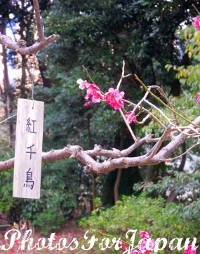 Miller Thomson associate (and one-time Precedent guest blogger) Melissa Ghislanzoni, experienced first-hand the Japanese earthquake and tsunami that caused so much devastation — and she’s turning her experience into a unique fundraising effort called Photos for Japan.
Miller Thomson associate (and one-time Precedent guest blogger) Melissa Ghislanzoni, experienced first-hand the Japanese earthquake and tsunami that caused so much devastation — and she’s turning her experience into a unique fundraising effort called Photos for Japan.
Melissa was in Japan for a vacation when the earthquake hit, and returned home with both a desire to help the country and a collection of stunning photos she took on her trip. Now, she’s set up a page on Etsy to sell prints of her photos [Ed. Note: No longer available] and donate the proceeds to support the Humanitarian Coalition’s work to help survivors of the disaster.
But that’s not her only motivation. Part of the caption below each of her pictures reads: “I also hope that these photos, some of which were taken about an hour before the earthquake and tsunami struck, will blend in your imagination alongside all of the images of devastation we are seeing on the news as a reminder of the beauty and resilience of Japan.”
Click here to view and purchase Melissa’s photos. (Note: Since there is an exchange of goods, no charitable tax receipt will be issued.)
Melissa took a moment to tell Precedent a bit about her experience in Japan, and her fundraising campaign.
Precedent: The photos on your Etsy page are gorgeous. Could you pick a favourite, and tell us a bit of the story behind it?
Melissa: Thank you! I’m going to pick the cherry blossom photo simply because it was the last one I took before the quake. The simplicity and beauty of that garden was the perfect foil to the amazing colours and enormity of the city. My friend and I had planned to walk across the Rainbow Bridge over the harbour but instead decided we were craving something more “zen.” I’m not sure what would have happened had we been on the bridge during the quake, but we’re so grateful that we were not. The sky was a crazy colour because a brilliantly sunny day turned into a rainy one in a matter of minutes and the rain made the already fragrant flowers smell even better.
I didn’t feel right taking any photos of the damage after the quake. I want to remember Japan as I saw it, while still acknowledging the devastation that took place.
Where were you when the earthquake hit? Were you in any danger?
We had just left the garden and had come out of Shinjuku subway station, which is a massive complex that processes about two million people per day! My friend and I were ordering food when the ground started to shake. At first, everybody around us looked fairly calm and so we assumed this was one of the small earthquakes that the Japanese are accustomed to. About a minute later when the ground was shaking so much that it was hard to stand up, however, it became clear that this was out of the ordinary. We ran and hid under a doorway outside a beautiful little grocery store and watched in disbelief as bottles of wine, sake and foods started flying off the shelves. We were safe because both Shinjuku station and our hotel are very new structures, built to withstand quakes.
The aftershocks were pretty scary, however. We hid under a metal staircase for the worst of the aftershocks during the day on Friday and, after a few hours, ended up being able to go back to our rooms. Watching CNN from our shaking hotel room was just devastating and the lobby of our hotel was filled with stranded people trying to make calls to their loved ones for hours afterwards.
The North American media commended the Japanese people for their calmness in the aftermath of the quake and tsunami. What do you remember about the reactions of locals in the wake of the disaster?
Everybody was so amazingly calm and kind. Nobody was stockpiling supplies. The girl in the corner store thanked us for buying wine (the shelves were bare, we figured we needed something!) Our hotel staff bent over backwards to ensure everybody — guests and those who were stranded — were as safe and comfortable as possible. People smiled at each other on the street and everybody did their best to carry on as usual, to ensure that services and products were delivered.
At Narita airport, there were literally thousands and thousands of people trying to leave Tokyo. Despite frequent and large aftershocks (one of which made my luggage bounce on the conveyor belt!), people were patient and helped everybody in need. There was a real sense of people pulling together.
Why did you choose the Humanitarian Coalition as the beneficiary of your campaign?
I really like knowing that the Humanitarian Coalition has partners on the ground in Japan and is able to help with immediate relief. I can’t imagine what is must be like to be stuck in an emergency shelter, having lost loved ones and all of your possessions.

